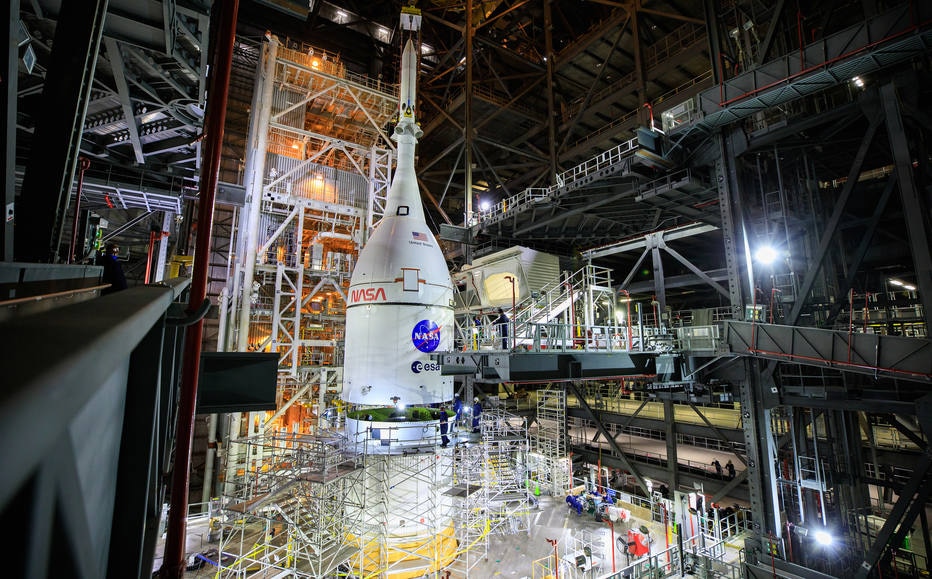With the Moon back in focus, the space race projects important advances for this and the next few years. main bet of NasaAmerican space agency, the Artemis program should start test expeditions this decade to send astronauts to the moon for the first time since 1972. Afterwards, the agency wants to use the same technologies to seek an unprecedented feat: to take man to Mars. After a busy year, countries like Russia and China have also made progress towards this goal.
Scientists heard by Estadão indicate that, as in the 1960s, there is now a new impetus to send expeditions to the Moon, which includes unmanned missions. Some of the plans, however, can be stopped in the face of war in ukrainewhich even compromises the maintenance of the International Space Station (ISSthe acronym in English).
Initially, NASA’s goal for the Artemis program was to get the first woman and first non-white astronaut to the surface of the Moon by 2024. In the 2020 project presentation document, then-NASA Administrator Jim Bridenstine said the The agency would use the Moon expedition as a “springboard for the next great leap – the human exploration of Mars.”
The schedule had to be postponed due to unforeseen events – the agency revealed that it will not complete Artemis before 2025 – but the program steps are advancing. NASA expects to complete what is considered the last major test this month before launching its mega-rocket Space Launch System (SLS), the most powerful developed so far, into orbit around the Moon. This fuel test was scheduled for early April, but has already had to be postponed three times for technicians to make minor repairs after problems such as a leak have been identified.
Named Artemis 1, the expedition planned for this year will be unmanned and will last about three weeks. It will simulate the route planned for the expedition with the astronauts, but without the spacecraft landing on the spot. “Everyone (and Nasa) is very excited about the Artemis mission, which will take people back to the Moon.” Estadão astronomer Rosaly Lopes, chief scientist in the area of Planetary Sciences at NASA’s Jet Propulsion Laboratory.
“The moon is more interesting than we thought at the end of the Apollo program (which landed man on the moon in the 1960s and 1970s). There was a lack of interest in the Moon, but then it came back”, he continued, attributing the resumption to new studies and recent expeditions. “We are in an interesting space exploration moment. It has several missions in the solar system and around Earth.”
Deadlines and challenges
The researcher considers, on the other hand, that the date for the launch of the Artemis manned mission is still open, even due to the complexity of the adventure. “Manned missions are much more difficult to do and also much more expensive,” said Rosaly, who has worked at NASA for more than 30 years. The estimated budget for the Artemis mission is around US$ 100 billion (R$ 470 billion), but the final amount depends on approval by the US Congress.
The mission that took astronauts to the Moon from 1969 to 1972 would have cost more than US$200 billion today, scientists estimate. “The technology that was used in the 1960s to go to the moon was very expensive,” says Adilson de Oliveira, a professor of physics at the Federal University of São Carlos (UFSCar). It was one of the reasons, he explains, that made missions to the Moon unfeasible for a long time.
“With this new project by Artemis, which they are doing in partnership with private companies, they have the possibility of advancing with other technologies”, he says. As an example, Oliveira cites a mechanism developed by Space Xbillionaire’s company Elon Muskto recover the rockets after launches, which makes the space mission cheaper.
Projects targeting the Moon aim to expand man’s presence in space and develop new technologies to reach Mars in the future. “The presence on the Moon is a training to go to other bodies in the Solar System”, says Alexandre Zabot, professor of Aerospace Engineering at the Federal University of Santa Catarina (UFSC). He recalls that while the ISS is less than 1,000 kilometers from Earth, the Moon is 380,000 kilometers away – a much greater challenge.
“The Moon has never been properly explored. The Apollo missions, for example, were only a fascination on the Moon. A deeper scientific mission has never been carried out”, says Oliveira. “Even in the Soviet phase, when they sent probes to remove material and bring it to Earth, this was very little analyzed.”
In addition to Artemis, NASA has two robots on Mars and is currently carrying out two important missions: the first is Psyche, which aims to study an asteroid similar to the Earth’s core an asteroid that is exposed,” says Rosaly. The launch is scheduled for this year and the return, for 2026. The second mission is Dart, whose objective is to test technologies to protect the Earth from possible collision with asteroids.
other missions
As part of the events planned for 2022, Roscosmos, the space agency of the Russia, announced the launch of the Luna 25 mission rocket to the Moon starting in the 2nd semester. The program was set up to send the agency’s first expedition to the Moon since 1976, during the Cold War period.
In parallel, the European Space Agency (ESA) leads the Juice program, whose launch of a probe to explore Jupiter’s moons should take place by next year, and ExoMars, in partnership with Roscosmos. In 2016, the first part of this second mission was successful and sent equipment to orbit around Mars. For this year, ExoMars forecast was to launch a robot to the Martian surface to look for signs of life from 2023, when it arrives on the red planet.
Dough war in ukraine compromised planning for Exomars. ESA reported last month the suspension of cooperation with the Russian agency for the mission. The conflict in Eastern Europe could also slip into the maintenance of the ISS, an orbiting laboratory developed by a coalition of 15 countries for more than 20 years to conduct research. Russia is one of the most important nations in the group.
At the beginning of March, the Russian space agency canceled the launch of a rocket loaded with more than 30 satellites from the British company OneWeb, a new chapter in the shake-up in space relations. That same month, the OneWeb announced that it would resume satellite launches through SpaceX.
Then, Dmitry Rogozin, head of the Russian agency, reacted more explicitly to the sanctions made by US President Joe Biden. He said he would no longer supply engines for the US Atlas and Antares rockets.
With the instability scenario, NASA indicated last month to study ways to keep the space station without assistance from Russia, which will still decide whether to remain on the station. “The United States already knew that it needed to cut its dependence on Russia, because there was instability”, analyzes Zabot.
China has also gained ground. The Asians started building their new space station in 2021, with completion scheduled for the end of this year. A few days ago, Chinese astronauts returned to Earth after an expedition of more than six months to work on the development of the station.
And, recently, Beijing said it planned a manned mission to Mars by 2033. “Like everything that involves China, these are exponential advances”, says Zabot, noting that the country had little expression in the space race of the 20th century.
According to Rosaly, the list of countries that were able to plan space missions was limited. “Now we see China, India, the United Arab Emirates, all doing missions. And this is very good.” As an example, she cites the landing of the Chinese robot Zhurong on the Martian surface in 2021, previously limited to Russians and Americans.
The Japanese space agency, Jaxa, is expected to present this year the Smart Lander for Investigating the Moon (Slim) lander, a new technology developed by the country. The South Korean space agency plans to launch its first lunar mission from Florida in August.
In parallel, SpaceX projects – who recently took the first private team to the ISS – and Blue Origin, owned by billionaire Jeff Bezos, partner with space agencies and promote a commercial flight race.
shy presence
No Brazil, advances in the space area are considered timid compared to other initiatives. “Of course, it is not possible to invest in the same proportion (which developed nations), but we are losing a lot right now. Every country has to master some technology, and space technology will prove to be important in the coming years”, points out Oliveira, from UFSCar.
According to the researchers, the programs developed in Brazil are more focused on Earth observation. One example is the Amazon 1 satellite, released in February last year in India.
–


